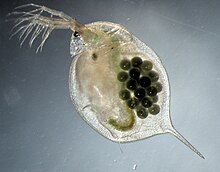Daphnia magna
| Daphnia magna | |
|---|---|
 |
|
| Female Daphnia magna with a clutch of asexual eggs. The animal is about 4 mm long. | |
| Scientific classification | |
| Kingdom: | Animalia |
| Phylum: | Arthropoda |
| Subphylum: | Crustacea |
| Class: | Branchiopoda |
| Order: | Cladocera |
| Family: | Daphtniidae |
| Genus: | Daphnia |
| Species: | D. magna |
| Binomial name | |
|
Daphnia magna Straus, 1820 |
|
Daphnia magna is a small planktonic crustacean (adult length 1.5–5 mm) that belongs to the subclass Phyllopoda. Daphnia magna inhabits a variety of freshwater environments and is broadly distributed throughout the northern hemisphere, and in South Africa.
Daphnia magna has been subject of biological research since the 18th century. It is widely used in ecological and evolutionary studies, and in ecotoxicology.Daphnia magna is also a popular fish food in aquaculture and aquariums.
Daphnia magna displays the general morphological features of the genus Daphnia. The females reach up to 5 mm in size, the males about 2 mm, and thus being among the largest Daphnia species. The body is protected by a translucent carapace, made of chitin, a transparent polysaccharide. It also presents a ventral opening, and has five pairs of thoracic limbs, which are used to help the filtering process. Spike rows run along the back of the carapace. The intestine is hook-shaped and possesses two digestive cecae. The head is equipped with two antennae and a large compound eye.
Adult females can be distinguished from those of otherwise similar species such as D. pulex by the absence of a comb on the abdominal claw and the presence of two distinct combs on the abdomen.The males are smaller than the females and have larger first antennas, a diagnostic feature that distinguishes them from small females.
D. magna is a key species in many lentic habitats. It can be found in lakes and in shallow ponds rich in organic matter sediment. Numerous natural predators are known and can lead to plastic phenotypic responses. In the presence of kairomones Daphnia develop conspicuous protective structures as an elongated spine and a large body size. It is an important primary consumer and, also, prey of many planktivorous fishes. Other invertebrate predators are the larvae of the phantom midge Chaoborus and hemipterans (Notonecta) and Triops. The large size of the adults protects them from predation from some planktivorous invertebrates.
...
Wikipedia
